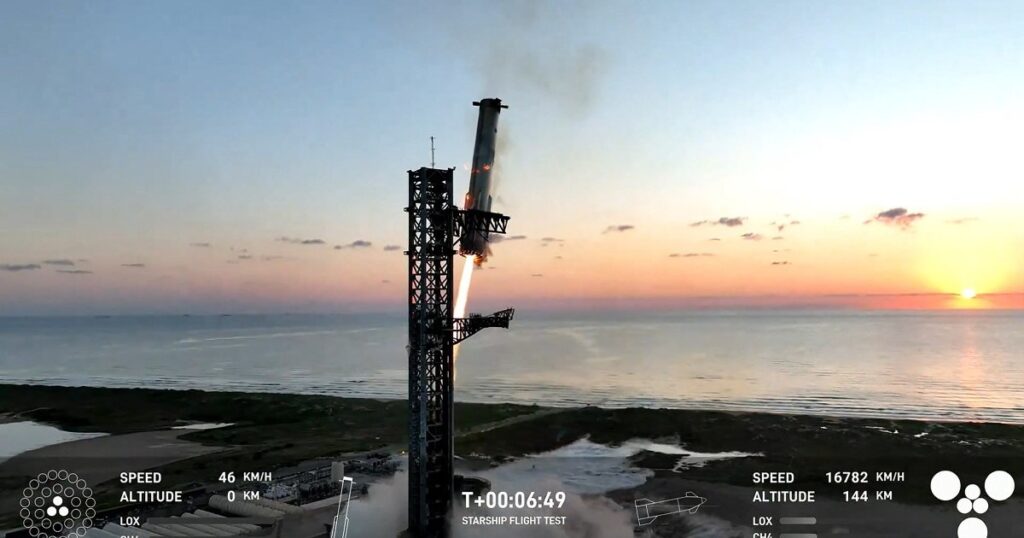SpaceX has launched its fifth Starship test flight from Texas and returned the rocket’s towering first-stage booster back to land for the first time, achieving a novel recovery method involving large metal arms.
The rocket’s Super Heavy first-stage booster lifted off at 7:25 am (12:25 GMT) on Sunday from SpaceX’s launch facilities in Boca Chica, Texas, sending the second-stage Starship rocket on a path in space bound for the Indian Ocean west of Australia, where it will attempt atmospheric reentry followed by a water landing.
The Super Heavy booster, after separating from the Starship booster some 74km (46 miles) in altitude, returned to the same area from which it was launched to make its landing attempt, aided by two robotic arms attached to the launch tower.
“The tower has caught the rocket!!” SpaceX founder Elon Musk posted on X.
Towering almost 121 metres (400 feet), the empty Starship arched over the Gulf of Mexico like the four Starships before it that ended up being destroyed, either soon after liftoff or while ditching into the sea. The last one in June was the most successful yet, completing its flight without exploding.
This time, Musk upped the challenge and risk. The company brought the first-stage booster back to land at the pad from which it had soared seven minutes earlier.
“Are you kidding me?” SpaceX’s Dan Huot observed with excitement near the launch site. “I am shaking right now.”
“This is a day for the engineering history books,” added SpaceX’s Kate Tice from SpaceX headquarters in Hawthorne, California.
It was up to the flight director to decide, in real-time with a manual control, whether to attempt the landing. SpaceX said both the booster and launch tower had to be in good, stable condition. Otherwise, it was going to end up in the gulf like the previous ones. Everything was judged to be ready for the catch.
Once free of the booster, the retro-looking stainless-steel spacecraft on top continued around the world, targeting a controlled splashdown in the Indian Ocean. The June flight came up short at the end after pieces came off. SpaceX upgraded the software and reworked the heat shield, improving the thermal tiles.
SpaceX said its engineers have “spent years preparing and months testing for the booster catch attempt, with technicians pouring tens of thousands of hours into building the infrastructure to maximise our chances for success.”
Teams were monitoring to ensure “thousands” of criteria were met both on the vehicle and at the tower before any attempt to return the Super Heavy booster.
Had the conditions not been satisfied, the booster would have been redirected for a splashdown in the Gulf of Mexico, as in previous tests.
Instead, having been given the green light, the returning booster decelerated from supersonic speeds and the powerful “chopstick arms” embraced it.
SpaceX has also been recovering the first-stage boosters of its smaller Falcon 9 rockets for nine years, after delivering satellites and crews to orbit from Florida or California. But they land on floating ocean platforms or on concrete slabs several miles from their launch pads – not on them.
Recycling Falcon boosters has sped up the launch rate and saved SpaceX millions.
Musk intends to do the same for Starship, the biggest and most powerful rocket ever built with 33 methane-fuel engines on the booster alone. NASA has ordered two Starships to land astronauts on the moon later this decade. SpaceX intends to use Starship to send people and supplies to the moon and, eventually, to Mars.
Founded only in 2002, SpaceX quickly leapfrogged aerospace industry giants and is now the world leader in orbital launches, besides providing the only US spaceship currently certified to carry astronauts.
It has also created the world’s biggest internet satellite constellation – invaluable in disaster and war zones.
But its founding vision of making humanity a multi-planetary species is increasingly at risk of being overshadowed by Musk’s embrace of Republican presidential candidate Donald Trump and his alignment with right-wing politics.
In recent weeks, the company has openly sparred with the Federal Aviation Administration over launch licensing and alleged violations, with Musk accusing the agency of overreach and calling for its chief, Michael Whitaker, to resign.
https://www.aljazeera.com/news/2024/10/13/spacex-catches-giant-starship-rocket-booster-in-fifth-flight-test?traffic_source=rss


